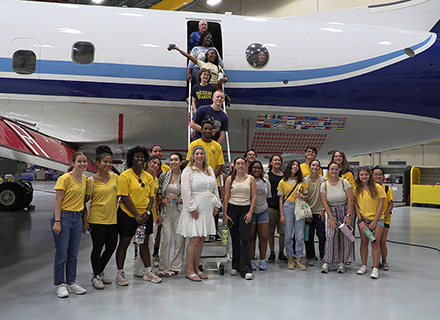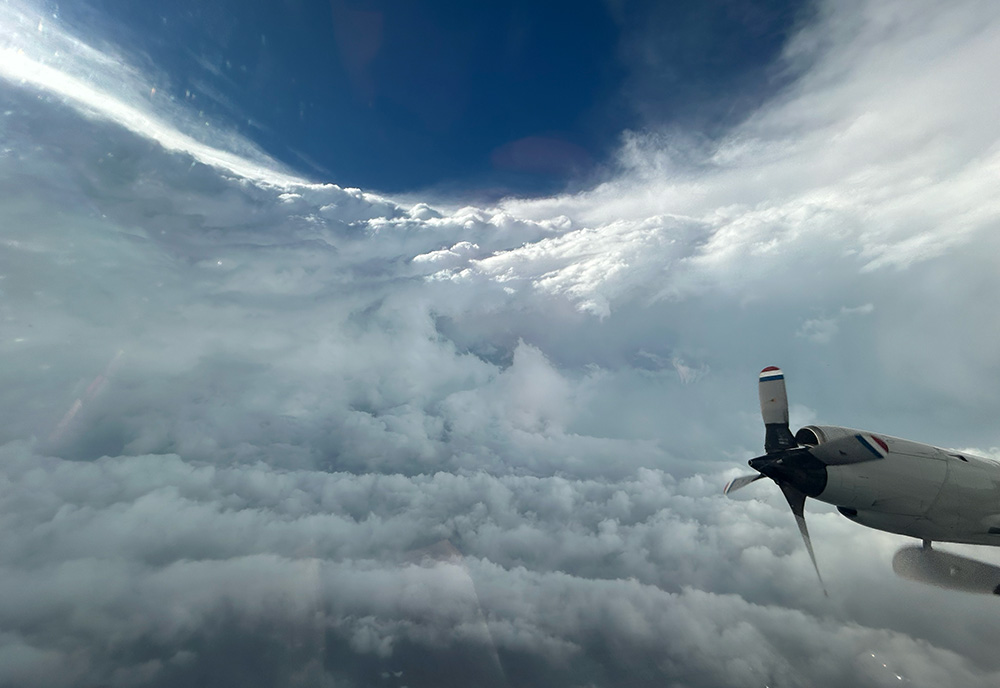By Sarah Sell, University Communications and Marketing
A group of undergraduate students visiting USF as part of a summer research program got an unexpected and rare glimpse of the National Oceanic & Atmospheric Administration’s (NOAA) Hurricane Hunters preparing to go on their first reconnaissance mission of the season.
The first Atlantic hurricane usually forms in early to mid-August. But Hurricane Beryl, currently in the Caribbean, became the earliest Category 5 ever recorded for the Atlantic Basin on July 1.
Several days before, at NOAA’s Aircraft Operations Center (AOC) in Lakeland, students who are part of the Research Experience for Undergraduates (REU) program took a tour of the facility, got onboard an airplane, met the flight directors and learned how specialized equipment collects vital data about storms. During their missions, the crew launches dropsondes, tube-shaped sensor devices that fall into the ocean and transmit data about hurricanes such as Beryl.
“We can get the data before the device splashes into the ocean,” said Richard Henning, NOAA Hurricane Hunters flight director. “It’s a great way to get the information directly to the National Hurricane Center to determine how strong the winds are in the eyewall of the storm.”

Students visiting USF for the REU summer research program toured "Miss Piggy" on June 28, the day before she was flown to the Caribbean for NOAA's first reconnaissance mission of the season.
Located at Lakeland Linder Regional Airport, the AOC houses a variety of aircraft, including two WP-3 Orions, one Gulfstream GIV-SP, one Gulfstream Turbo Commander, one Beechcraft King Air 350ER and four de Havilland Twin Otters. AOC also serves as a workplace for over 100 NOAA officers, scientists and staff.
“We are very privileged to have such great opportunities nearby,” said Jennifer Collins, a professor in USF’s School of Geosciences whose research focuses on weather and climate. “We have the NOAA Hurricane Hunters in Lakeland, the National Weather Service in Ruskin. We have all these opportunities right here in our backyard.”
Collins’ students are focusing on oceanography, weather, climate change and science communication as part of the REU. The program gives students the interdisciplinary research skills needed for graduate school and future careers.
“A lot of colleges don’t have good research experiences, so I wanted to come to USF and get some experience, make connections and figure out what I’d like to do,” said Jack Gulisano, a student at Central Michigan University majoring in meteorology. “After being here, I think I’m interested in emergency management. We’ve learned a lot of different disciplines, and that one stuck out to me.”
Funded by the National Science Foundation (NSF), students in the REU at USF are paid to work alongside faculty and other researchers who are conducting NSF-funded research. The students receive a stipend for travel, food and accommodations on campus.
